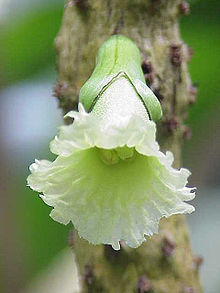
Back Bignoniaceae Afrikaans بغنونيات Arabic بنيونيه ARZ Bignoniaceae AST Biqnoniyakimilər Azerbaijani Бігноніевыя Byelorussian বিগ্নোনিয়াসি Bengali/Bangla Bignoniaceae BS Bignoniàcies Catalan Bignoniaceae CEB
| Bignoniaceae Temporal range:
| |
|---|---|

| |
| Bigleaf black calabash (Amphitecna macrophylla) | |
| Scientific classification | |
| Kingdom: | Plantae |
| Clade: | Tracheophytes |
| Clade: | Angiosperms |
| Clade: | Eudicots |
| Clade: | Asterids |
| Order: | Lamiales |
| Family: | Bignoniaceae Juss.[2] |
| Type genus | |
| Bignonia | |
| Monophyletic groups | |
| Synonyms | |
|
Crescentiaceae Dumortier
| |
Bignoniaceae (/bɪɡˌnoʊniˈeɪsiiː/)[3] is a family of flowering plants in the order Lamiales commonly known as the bignonias or trumpet vines.[4] It is not known to which of the other families in the order it is most closely related.[5]
Nearly all of the Bignoniaceae are woody plants, but a few are subwoody, either as vines or subshrubs. A few more are herbaceous plants of high-elevation montane habitats, in three exclusively herbaceous genera: Tourrettia, Argylia, and Incarvillea.[6] The family includes many lianas, climbing by tendrils, by twining, or rarely, by aerial roots. The largest tribe in the family, called Bignonieae, consists mostly of lianas and is noted for its unique wood anatomy.[7]
The family has a nearly cosmopolitan distribution, but is mostly tropical, with a few species native to the temperate zones. Its greatest diversity is in northern South America.[7] The family has been covered in some major floristic projects, such as Flora of China, Flora Malesiana, and Flora Neotropica. It has not yet been covered in some others, such as Flora of Australia, and Flora of North America.
Bignoniaceae are most noted for ornamentals, such as Jacaranda, Tabebuia and Spathodea, grown for their conspicuous, tubular flowers.[8] A great many species are known in cultivation.[9] Various other uses have been made of members of this family.[10] Several species were of great importance to the indigenous peoples of the American tropics.[11] Fridericia elegans, Tanaecium bilabiata, and Tanaecium excitosum are poisonous to livestock and have caused severe losses.[11]
According to different accounts, the number of species in the family is about 810[12] or about 860.[7] The last monograph of the entire family was published in 2004.[7] In that work, 104 genera were recognized. Since that time, molecular phylogenetic studies have greatly clarified relationships within the family, and the number of accepted genera is now between 80 and 85.[13]

- ^ Wilf, Peter (February 2000). "Late Paleocene-early Eocene climate changes in southwestern Wyoming: Paleobotanical analysis". Geological Society of America Bulletin. 112 (2): 292–307. Bibcode:2000GSAB..112..292W. doi:10.1130/0016-7606(2000)112<0292:LPEECC>2.3.CO;2. Retrieved 15 May 2020.
- ^ Angiosperm Phylogeny Group (2009), "An update of the Angiosperm Phylogeny Group classification for the orders and families of flowering plants: APG III", Botanical Journal of the Linnean Society, 161 (2): 105–121, doi:10.1111/j.1095-8339.2009.00996.x, hdl:10654/18083
- ^ "Bignoniaceae". Merriam-Webster.com Dictionary. Retrieved 2023-06-11.
- ^ Vernon H. Heywood, Richard K. Brummitt, Ole Seberg, and Alastair Culham. Flowering Plant Families of the World. Firefly Books: Ontario, Canada. (2007). ISBN 978-1-55407-206-4.
- ^ Peter F. Stevens (2001 onwards). "Bignoniaceae" At: Angiosperm Phylogeny Website. At: Botanical Databases At: Missouri Botanical Garden Website. (see External links below)
- ^ Olmstead, Richard G.; Zjhra, Michelle L.; Lohmann, Lúcia G.; Grose, Susan O.; Eckert, Andrew J. (2009). "A molecular phylogeny and classification of Bignoniaceae". American Journal of Botany. 96 (9): 1731–1743. doi:10.3732/ajb.0900004. PMID 21622359.
- ^ a b c d Eberhard Fischer, Inge Theisen, and Lúcia G. Lohmann. 2004. "Bignoniaceae". pages 9-38. In: Klaus Kubitzki (editor) and Joachim W. Kadereit (volume editor). The Families and Genera of Vascular Plants volume VII. Springer-Verlag: Berlin; Heidelberg, Germany. ISBN 978-3-540-40593-1
- ^ George W. Staples and Derral R. Herbst. 2005. "A Tropical Garden Flora" Bishop Museum Press: Honolulu, HI, USA. ISBN 978-1-58178-039-0
- ^ Anthony Huxley, Mark Griffiths, and Margot Levy (1992). The New Royal Horticultural Society Dictionary of Gardening. The Macmillan Press, Limited: London. The Stockton Press: New York. ISBN 978-0-333-47494-5 (set).
- ^ Gentry, Alwyn H. (1980). ""Bignoniaceae: Part I (Crescentieae and Tourrettieae)". Flora Neotropica". Monograph. 25 (1): 1–130. JSTOR 4393736.
- ^ a b Gentry, Alwyn H. (1992). "A Synopsis of Bignoniaceae Ethnobotany and Economic Botany". Annals of the Missouri Botanical Garden. 79 (1): 53–64. doi:10.2307/2399809. JSTOR 2399809.
- ^ David J. Mabberley. 2008. Mabberley's Plant-Book third edition (2008). Cambridge University Press: UK. ISBN 978-0-521-82071-4
- ^ Lúcia G. Lohmann and Carmen U. Ulloa. 2007 onward. Bignoniaceae in iPlants prototype Checklist. (See External links below).
© MMXXIII Rich X Search. We shall prevail. All rights reserved. Rich X Search